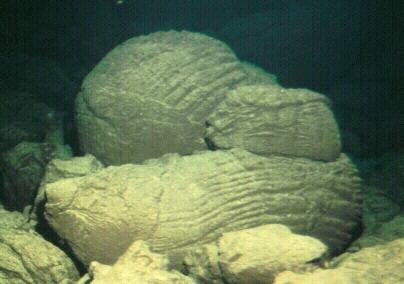|
Volcanism in the Galapagos Islands Pillow Lava  | |
Rhyolite is very rare in an oceanic environment like the Galapagos, but it is not unheard of. The major difference between the two rocks is that rhyolite has a much higher silica content. It is generally lighter in color and has larger crystals. Rhyolite is generally confined to continental crust and is produced during the most violent eruptions.
Tephra is pyroclastic material that cool and solidify while being projected into the air. Pyroclastic materials are defined by many different sizes, ranging from bombs to gray-white pumice pieces to ashes. An example of this can be seen on Alcedo volcano, Isabela Island. Another type of volcanic projectile is scoriae, pieces of shapeless, fluid magma.
Fumeroles are volcanic gas emissions that escape into the atmosphere. Fumeroles can last anywhere from a week to any number of decades, depending on the longevity of the heat source. They can occur in groups or alone, in the shape of a vent or fissure, or even within a lava or pyroclastic flow. Fumeroles are very important during eruptions because the rising gas helps push the magma out of the conduit.
Submarine volcanoes, like the early formation of the Galapagos Islands, eject magma that reacts violently with the cold water. The ejected material either forms volcanic tuffs or hyaloclastites. Submarine volcanic tuffs, or guyots, are formed by volcanic fragments, ranging in size from dust to massive blocks, that have consolidated and cemented together. Hyaloclastites is a Greek word meaning 'broken pieces of glass'. At deeper submarine volcanoes the eruptions are less explosive. When the slope is gentle, lava flows form jointed blocks with a polygonal structure. When the slope is steep, the lava flow breaks apart and forms 'pillow lava', or lava cushions.
|







